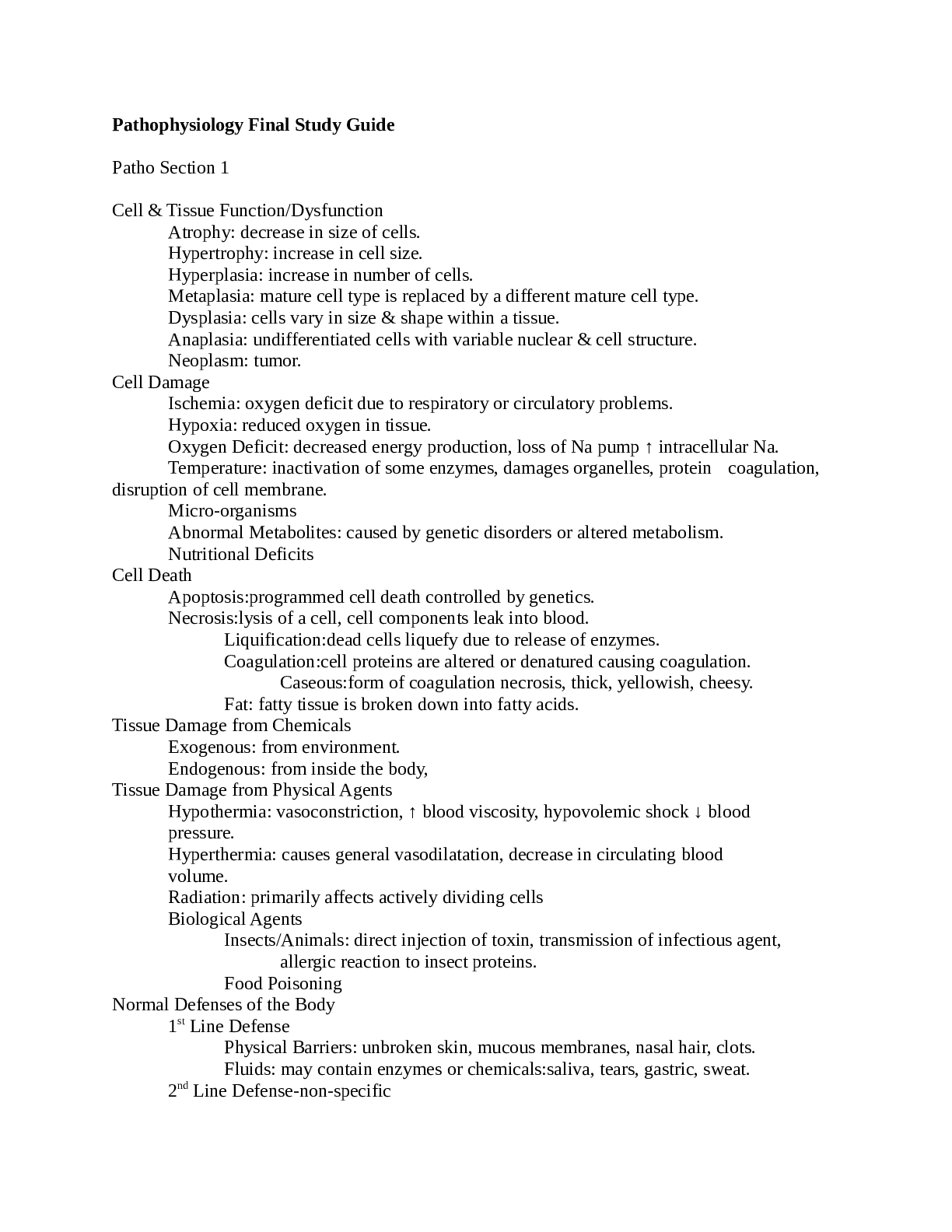*NURSING > QUESTIONS & ANSWERS > Mental Health Exam 1,VERIFIED ANSWERS 2022/2023 (All)
Mental Health Exam 1,VERIFIED ANSWERS 2022/2023
Document Content and Description Below
Discuss prominent theories and therapeutic models o Behavioral Therapy: attempts to correct or eliminate maladaptive (bad) behaviors/responses by rewarding & reinforcing adaptive (good) behavior. U... se of Desensitization, Aversion Therapy (becoming not afraid of spiders), Biofeedback and Modeling as well as the below 3 items. Pavlov, Watson & Skinner Pavlov: Classical Conditioning (Ex: baby cries and mom has milk “let-down” reflex). Watson: Personality traits & responses were learned (conscious) behavior. Skinner: Operant Conditioning. Behaviors are learned through Positive/Negative Reinforcement (Ex: studying hard results in good grades). o Cognitive Behavioral Therapy: combines both behavioral and cognitive theory and seeks to modify negative thoughts that lead to dysfunctional emotions & actions. This is useful for those patients who feel incompetent, abandoned, evil or vulnerable. It is NOT the stimulus (situation/person/place/thing) that causes the response; it is the person’s evaluation & selfthoughts about the situation that causes the negative feelings/reaction. Therapy aims to remove these negative/repetitive thoughts and replace them with rational interpretations of situations. Ex: “Matt had a car accident. He now refuses to drive and says, “I shouldn’t be allowed on the road”. (This is distorted thinking and rationalization of his car accident). o Milieu Therapy: Creating a SAFE, structured inpatient/outpatient setting where the mentally ill can test new behaviors and coping mechanisms with others. Creating a SAFE, structured inpatient/outpatient setting where patients with mental illness can test new behaviors and interactions. Climate is essential to healing: paint color, relaxed environments are conducive to the healing process. Florence Nightingale believed that the environment helps heal o Maslow’s Hierarchy of Needs: Basic needs on the bottom of the pyramid have to be met before the top (self-actualization) can be attained. 1. Physiological Needs – most basic needs that a human needs (food, water, O2, sleep, sex, body temperature, elimination, voiding). This level takes priority over all others. Assess Your Knowledge Mental Health Exam 1 2. Safety Needs – security, protection, and freedom from fear/anxiousness/chaos, law, order and limitations. 3. Belonging & Love Needs – The need for love, affection, intimate relationships and belonging will see to overcome feelings of loneliness and alienation. (Having a Family and a Home is very important). 4. Esteem Needs – If this need is met, we feel confident, valued and valuable. If this need is NOT met, we feel inferior, worthless and helpless. 5. Self-Actualization – What we strive to become as humans. Fulfillment of this need brings inner piece and contentment with ones self. Describe the role of neurotransmitters: dopamine, serotonin, and norepinephrine, GABA Dopamine: controls emotional responses, the brain’s reward and pleasure centers, stimulates heart and increases blood flow to organs. (Haloperidol = dopamine blocker). Cocaine allows more of dopamine to stay active for longer = increased HR, etc. o EPS is the result of Dopamine blockers (Dopamine needs to get through for proper brain functioning!) o Disorders with HIGH levels: Schizophrenia, Mania o Disorders with LOW levels: Depression, Parkinson’s Disease Serotonin: Regulates mood, arousal, attention, behavior, and body temperature. Most anti-depressants increase Serotonin production. Muscle Relaxants block serotonin production. Serotonin release by platelets play important role in homeostasis. o High levels of Serotonin S/Sx: causes restlessness, shivering, diarrhea, muscle rigidity, fever and seizures. o Disorders with HIGH levels: Anxiety o Disorders with LOW levels: Depression Norepinephrine: Regulate mood. A deficiency can cause Depression and excess can cause Mania. o Disorders with HIGH levels: Mania, Anxiety, Schizophrenia o Disorders with LOW levels: Depression GABA: inhibitory neurotransmitter that regulates excitability and helps treat anxiety by helping you “chill out”. Anti-Anxiety Meds help increase the effectiveness of GABA by making the receptors more responsive. o Disorders with HIGH levels: Reduction of Anxiety o Disorders with LOW levels: Mania, Anxiety, Schizophrenia Describe the phases of the nurse-client relationship, and what occurs during each phase (Hildegard Peplau) 1. Orientation Phase: first time the nurse & patient meet, interact according to their own backgrounds/standards/values/beliefs, [Show More]
Last updated: 1 year ago
Preview 1 out of 12 pages
Instant download
.png)
Buy this document to get the full access instantly
Instant Download Access after purchase
Add to cartInstant download
Reviews( 0 )
Document information
Connected school, study & course
About the document
Uploaded On
Nov 12, 2022
Number of pages
12
Written in
Additional information
This document has been written for:
Uploaded
Nov 12, 2022
Downloads
0
Views
71





